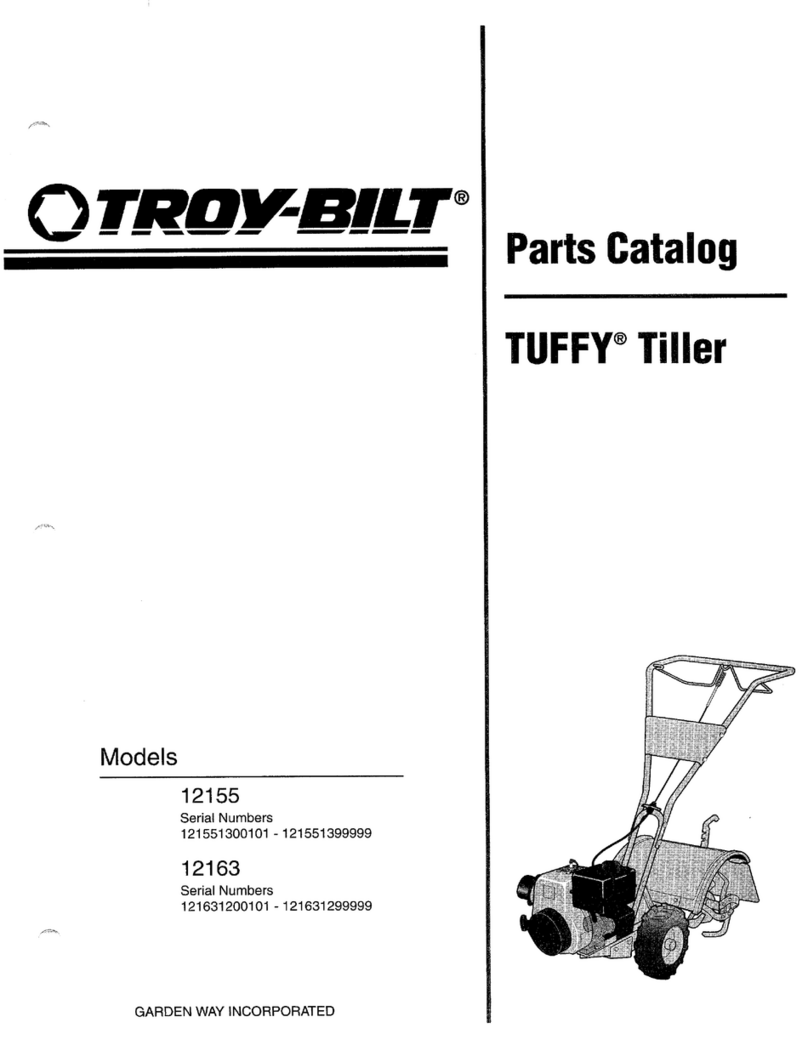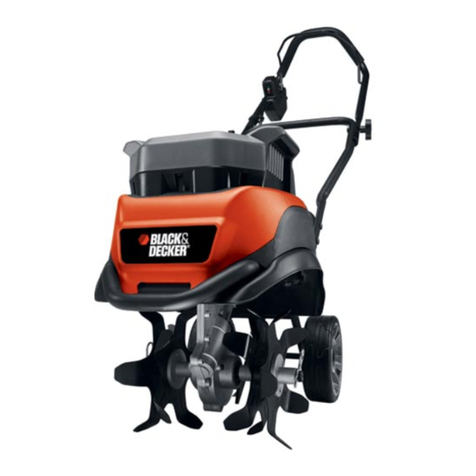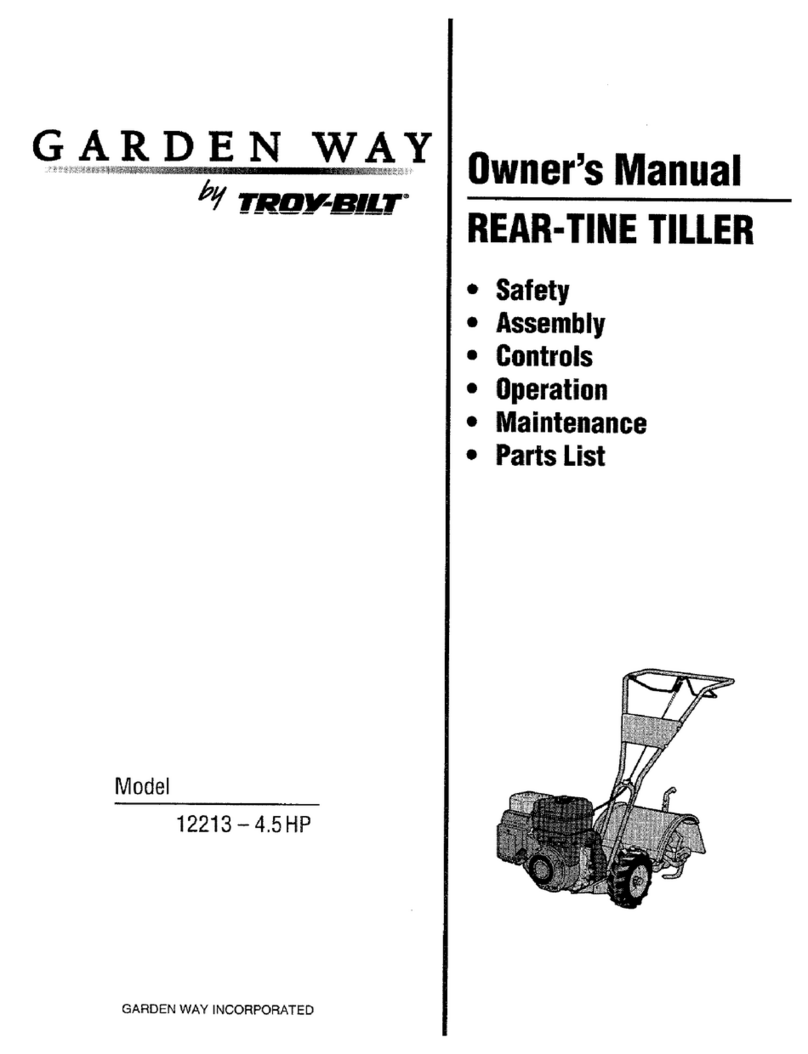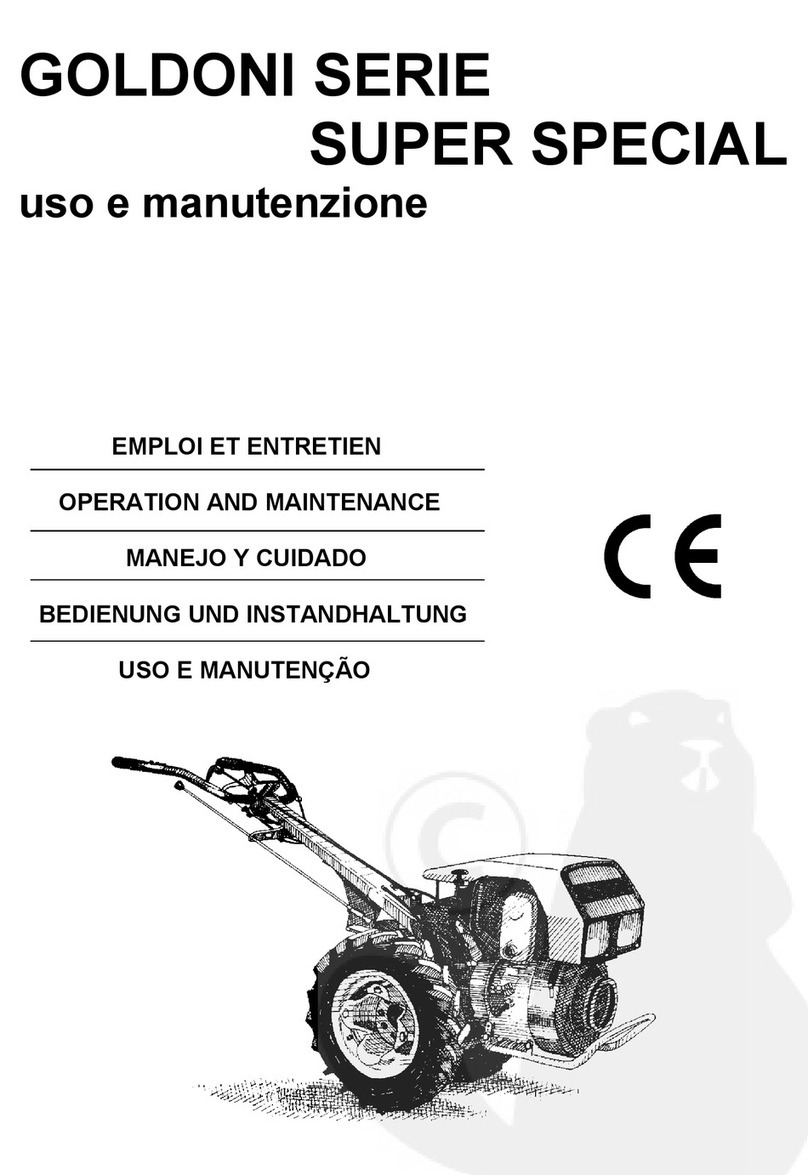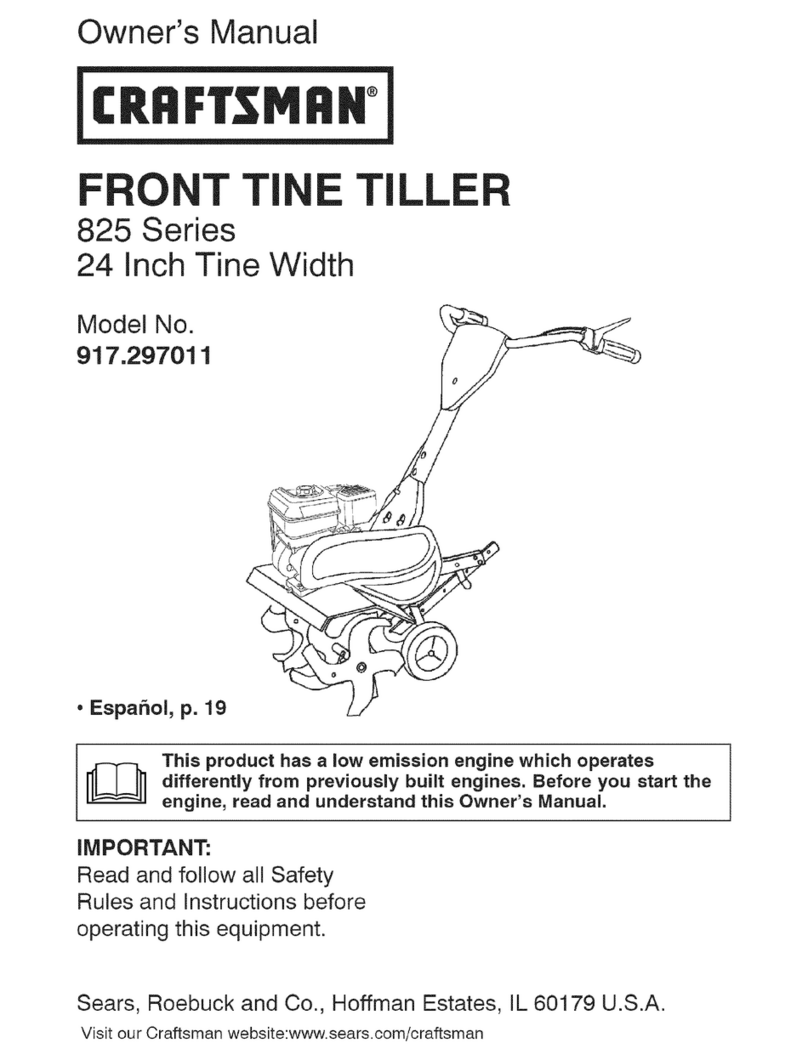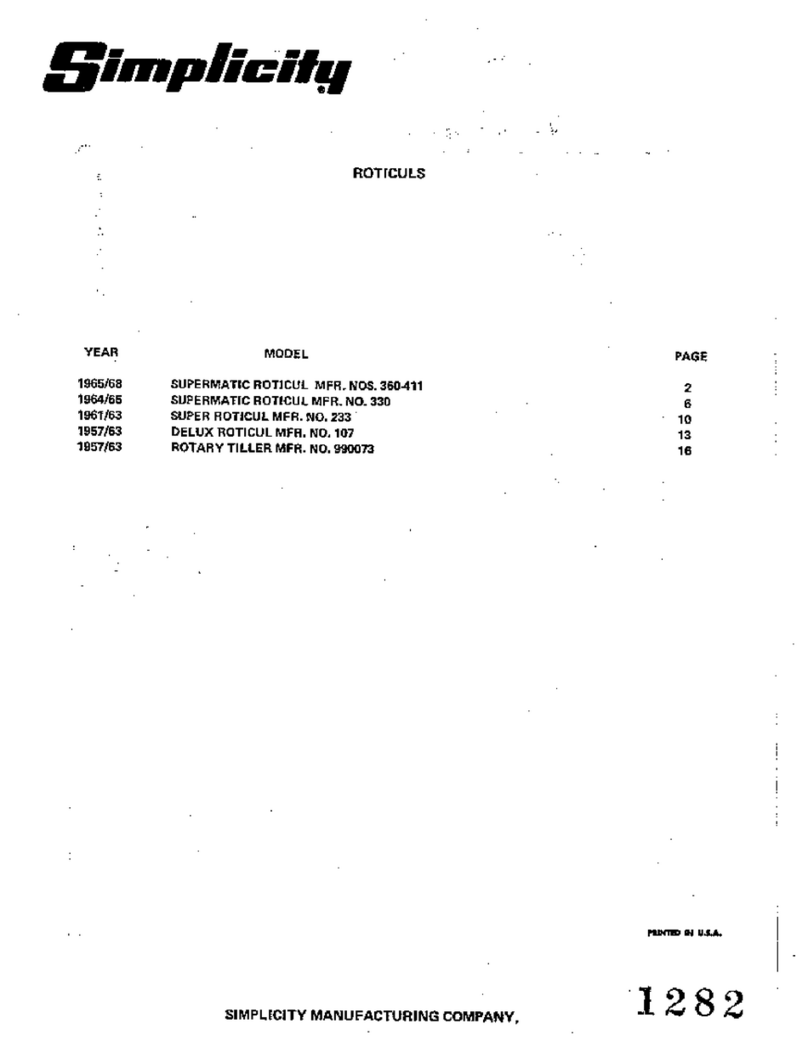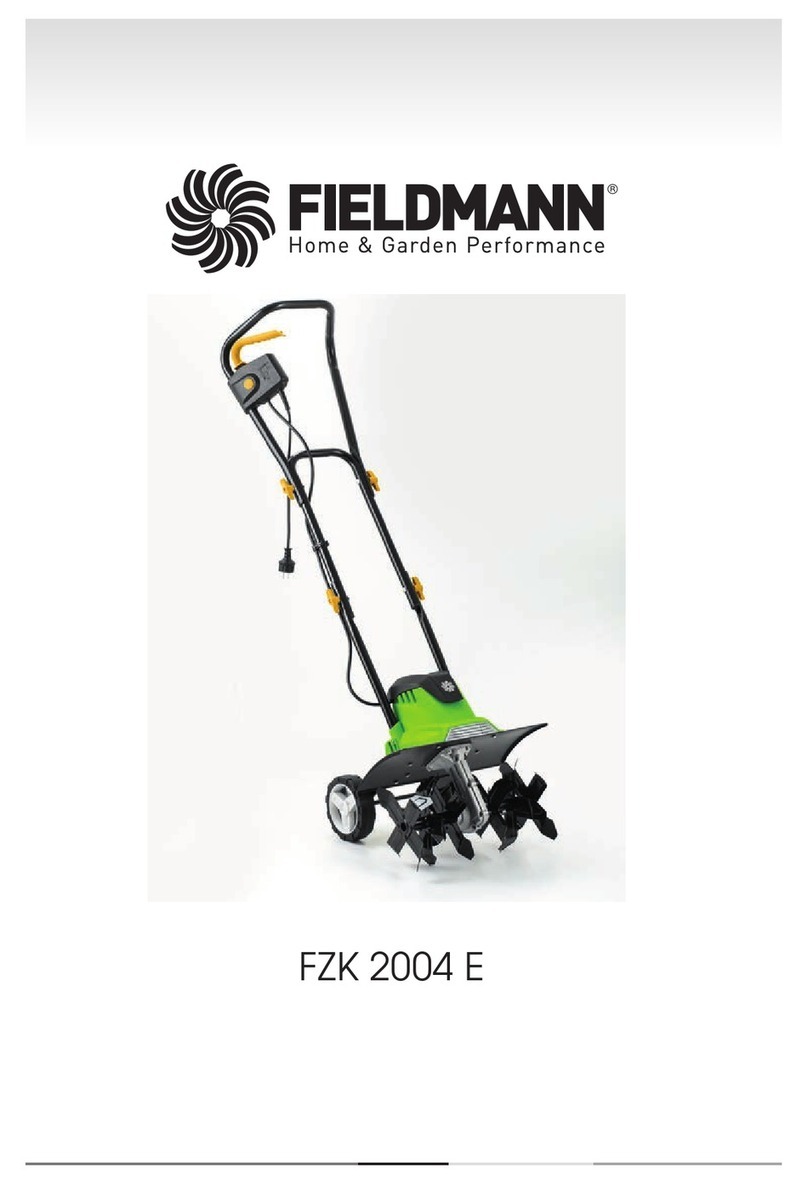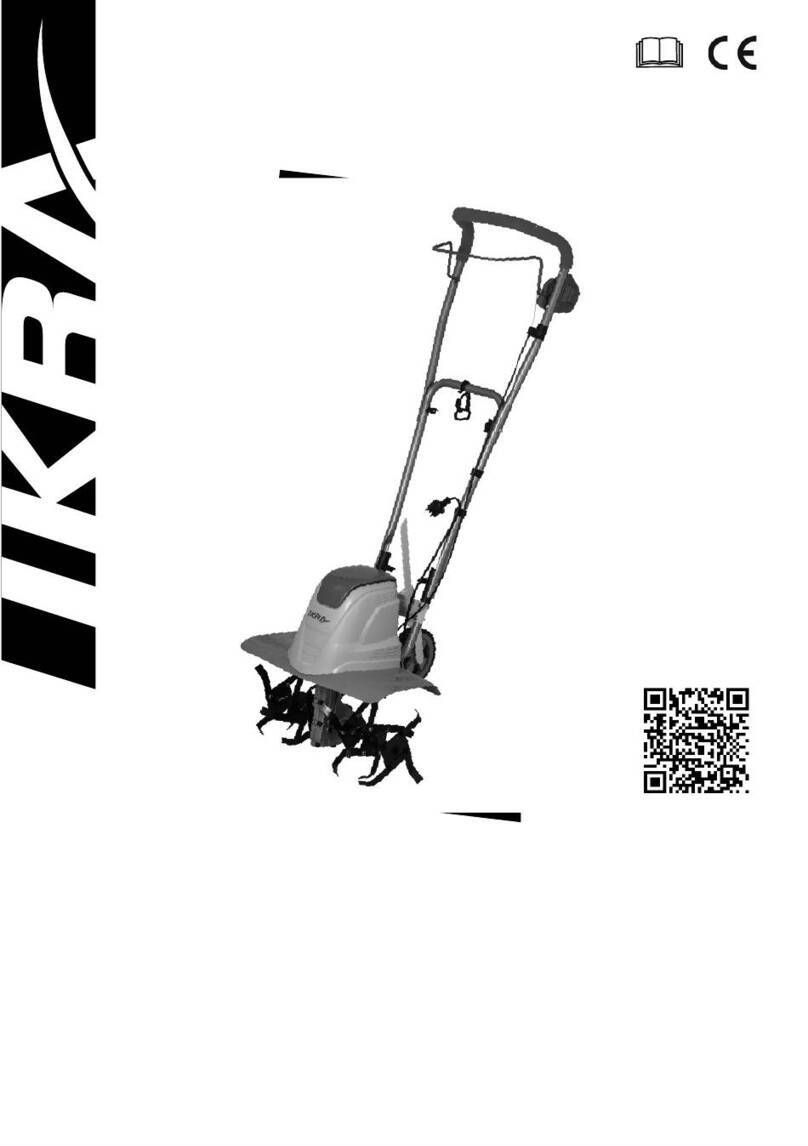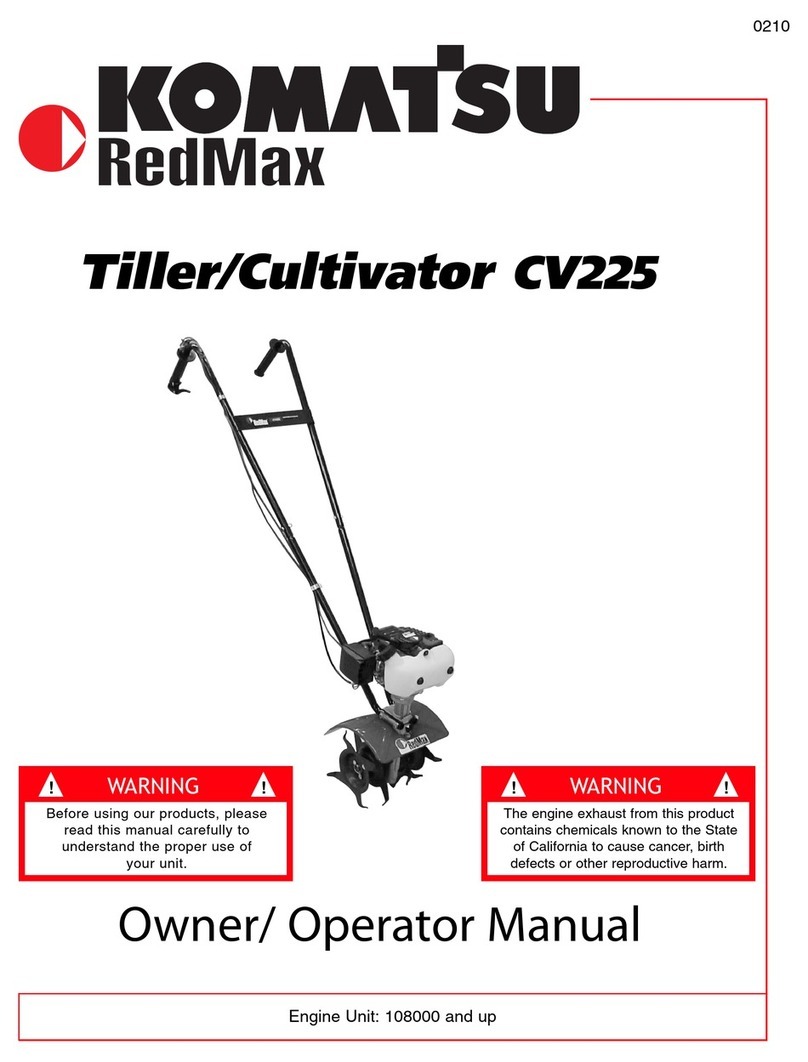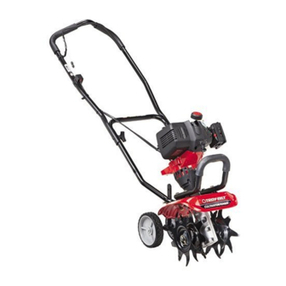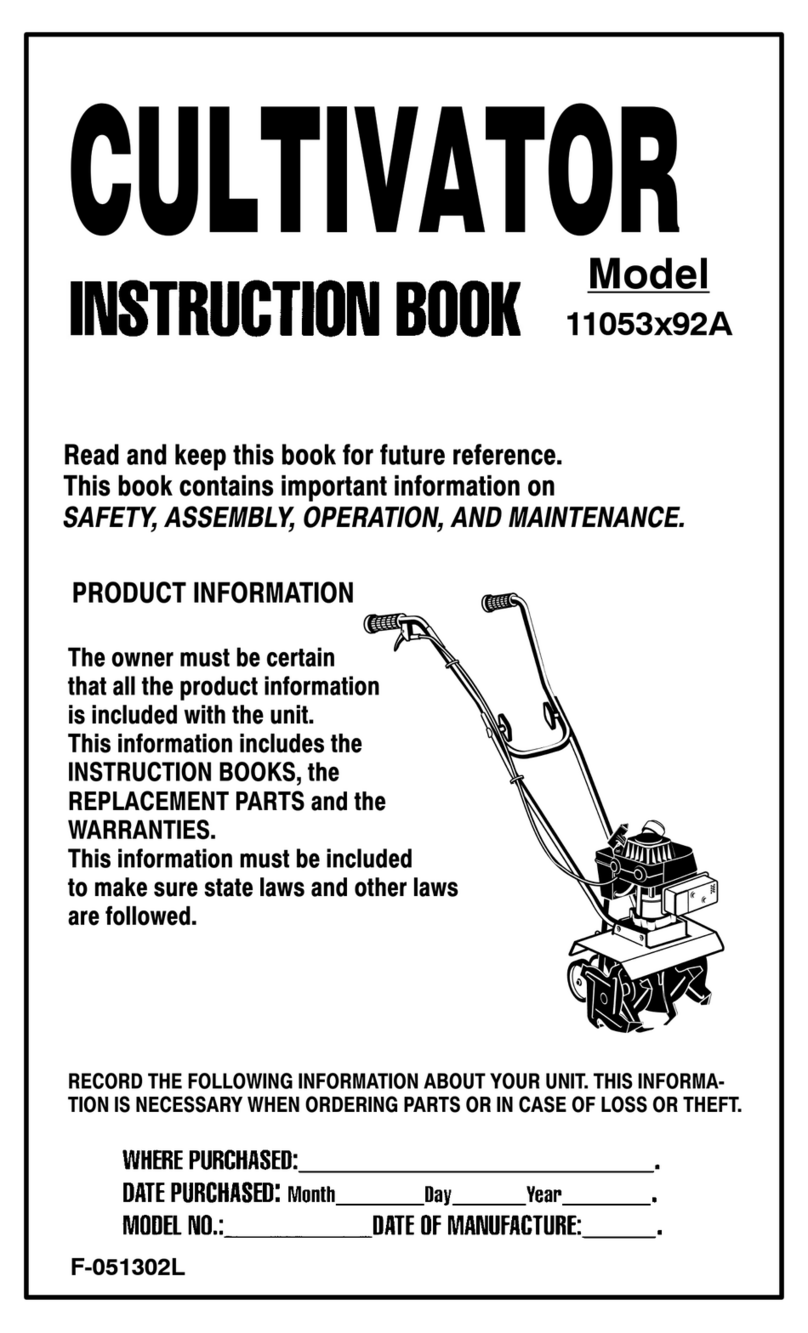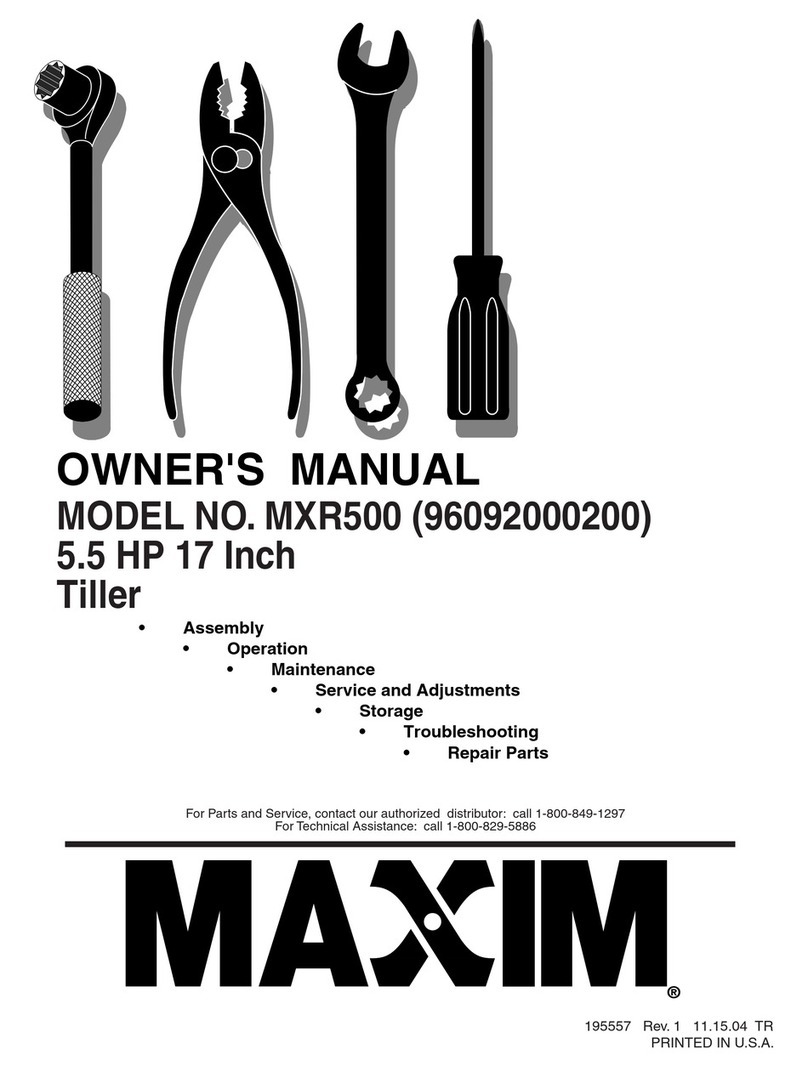MACKISSIC RT1450IC User manual

2
SECTION I –SAFETY
THIS REAR TINE TILLER IS INTENDED FOR CULTIVATING SOIL. IT IS DESIGNED FOR
THIS PURPOSE, AND ANY OTHER USE MANY CAUSE INJURY.
This symbol points out important safety instructions, which, if not followed, could
endanger the personal safety and/or property of yourself and others. Read and
follow all instructions in this manual before attempting to operate your tiller. Failure
to comply with these instructions may result in personal injury. When you see this
symbol –heed its warning.
DANGER: Rotating tines and belt
Keep hands and feet out of tines and belt area while machine is running.
DANGER: This machine can CRUSH, CUT and SEVER parts of your body if they
enter the operating areas of the rear tine tiller.
DANGER: Your rear tine tiller was built to be operated according to the rules for
safe operation in this manual. As with any type of power equipment,
carelessness or error on the part of the operator can result in serious injury. If
you violate any of these rules, you may cause serious injury to yourself or others.
WARNING: The engine exhaust from this product contains chemicals known to the
state of California to cause cancer, birth defects or other reproductive harm.

3
MAKE CERTAIN THAT ALL SAFETY LABELS ON THIS EQUIPMENT ARE KEPT CLEAN
AND IN GOOD CONDITION. IF YOU NEED REPLACEMENT LABELS, PLEASE ORDER BY
PART NUMBER.
PART # 091-0057
PART # 091-0070
PART # 091-0085

4
PART # 712-0074
712-0074
PART # 091-0085
OPERATING INSTRUCTIONS
STARTING: STOPPING:
Adjust drag bar for proper depth and tilling Release both handle levers.
conditions. Place shift arm in N (neutral) position.
Make certain that both handle levers have Move throttle to slow or stop.
dropped into disengage position. Turn engine switch to OFF.
Place shift arm in N (neutral) position.
Move throttle to RUN position. REVERSE:
Move choke to CHOKE position. Release both handle levers.
Move engine ON/OFF switch to ON position. Check behind for any obstacles.
Stand to side of tiller and pull starter rope. Reduce throttle speed.
As engine starts move choke lever to RUN. Place shift arm in R (reverse) position.
Move throttle to desired speed. Engage left hand lever to engage wheels.
TILLING: TRANSPORT:
Make certain that both handle levers have Release both handle levers.
dropped into disengage position. Place shift arm in 3 (3rd gear).
Place shift arm in 1 (first gear). Engage left hand lever to engage wheels.
Move throttle to ¾ speed. DO NOT TILL IN 3RD GEAR.
Engage left hand lever to engage wheels.
Engage right hand lever to engage tines.
Adjust downward pressure on dragbar as
required.
For difficult tilling conditions and breaking fresh
sod, put the dragbar foot in the up position.
For normal tilling conditions, use the dragbar
Foot in the down position.

5
GENERAL PREPARATION
Read the owner’s manual carefully and in its
entirety before attempting to assemble or use
this machine. Be thoroughly familiar with the
controls and the proper use of the equipment
before operation. Know how to stop the unit
and disengage the controls quickly.
Your tiller is a powerful tool, not a plaything.
Therefore, exercise extreme caution at all
times.
Never allow children to operate this
equipment. Only responsible adults who are
familiar with these rules of safe operation
should be allowed to use your unit.
Keep the area of operation clear of all
persons, particularly small children, and pets.
Thoroughly inspect the area where the
equipment is to be used and remove all
foreign objects.
Wear sturdy rough-soled work shoes and
close fitting slacks and shirt. Slacks that
cover the legs and steel-toed shoes are
recommended. Secure hair above shoulders
and do not wear loose clothes that can be
caught in moving parts. Never operate a unit
in bare feet, sandals or sneakers.
Do not operate while under the influence of
alcohol or drugs.
If the tines strike a foreign object or if your
machine should start making an unusual
noise or vibration, immediately stop the
engine and allow all moving parts to come to
a complete stop. Disconnect the spark plug
wire and move it away from the spark plug.
Take the following steps: 1) Inspect for
damage; 2) Repair or replace any damaged
parts; 3) Check for any loose parts and
tighten to assure continued safe operation.
Handle fuel with care; it is highly flammable.
Refer to engine manual for safety and
service instructions.
Disengage tines and wheels before starting
the engine (motor).
Never attempt to make any adjustments
while the engine (motor) is running (except
where specifically recommended by the
manufacturer).
DO NOT put hands or feet near or under any
rotating or moving parts.
Exercise extreme caution when operating on
or crossing gravel drives, walks, or roads.
Stay alert for hidden hazards of traffic. Do
not carry passengers.
Stop the engine (motor) when leaving the
operating position. Disconnect the spark
plug and be sure that all moving parts have
stopped before unclogging the tines, and
when making any repairs, adjustments, and
inspections.
Periodically check tines and remove any
vines or garden debris that may be wrapped
around the tine shaft. Before cleaning,
repairing, or inspecting, shut off the engine
and make certain all moving parts have
stopped. Disconnect the spark plug wire and
keep the wire away from the plug to prevent
accidental starting.
Do not run the engine indoors; exhaust
fumes are dangerous.
NEVER operate the tiller without proper
guards, plates, or other safety protective
devices in place.
Do not overload the machine’s capacity by
attempting to till too deep at too fast a rate.
Only operate your tiller in good daylight. Do
not operate tiller at night or in dark areas
where your vision may be impaired.
Be careful when tilling in hard soil or frozen
ground. The tines may catch in the ground
and propel the tiller forward. If this occurs,
release the handle levers to stop forward
motion.

6
CHILDREN
Tragic accidents can occur if the operator is not alert to the presence of small children.
Keep children out of the work area and under the watchful eye of a responsible adult other than the
operator.
Be alert and turn the unit off if a child enters the area.
Never allow children under the age of 16 to operate the tiller.
REPAIR AND MAINTENANCE SAFETY
Use extreme care in handling gasoline and
other fuels. They are extremely flammable
and the vapors are explosive.
Store fuel and oil in approved containers,
away from heat and open flame, and out of
the reach of children. Check and add fuel
before starting the engine. Never remove
gas cap or add fuel while the engine is
running. Allow engine to cool at least three
minutes before refueling.
Replace gasoline cap securely and wipe off
any spilled gasoline before starting the
engine as it may cause a fire or explosion.
Extinguish all cigarettes, cigars, pipes and
other sources of ignition.
Never refuel unit indoors because flammable
vapors will accumulate in the area.
Never store the machine or fuel container
inside where there is an open flame or spark,
such as a gas hot water heater, space
heater, clothes dryer or furnace.
Never run this machine in an enclosed area
as the exhaust from the engine contains
carbon monoxide, which is an odorless,
tasteless, and deadly poisonous gas.
To reduce fire hazard, keep engine and
muffler free of debris build-up. Clean up fuel
and oil spillage. Allow unit to cool at least
five minutes before storing.
Before cleaning, repairing, or inspecting, stop
the engine and make certain the tines and all
moving parts have stopped. Disconnect the
spark plug wire and keep wire away from
spark plug to prevent accidental starting. Do
not use flammable solutions to clean air filter.
Check the belt and engine mounting screws
at frequent intervals for proper tightness.
Also visually inspect tines for wear or
damage. Use only replacement tines, which
meet original manufacturer’s specifications.
Never tamper with safety devices. Check
their proper operation regularly. Be sure all
safety guards and shields are in proper
position. These safety devices are for your
protection.
Never operate your tiller in poor mechanical
condition or when in need of repair.
Periodically check and keep all nuts, bolts,
and screws tight to be sure the equipment is
in safe working condition.
Inspect the belt each time you use the unit.
Look for damage, worn areas, or tears. Do
not use the unit if this condition exists.
If your machine strikes any foreign object or
starts making an unusual noise or vibration,
immediately shut off engine, disconnect
spark plug wire from spark plug, and allow all
moving parts to come to a complete stop.
Inspect for damage and repair and/or replace
damaged parts. Check for and tighten any
loose parts.
Do not tamper with the engine’s governor
setting. The governor controls the maximum
safe operation speed and protects the
engine. Over-speeding the engine is
dangerous and will cause damage to the
engine and to the other moving parts of the
machine. See your authorized dealer for
engine governor adjustments.

7
YOUR RESPONSIBILITY
Restrict the use of this power machine to persons who read, understand and
follow the warnings and instructions in this manual and on the machine.
SAVE THESE INSTRUCTIONS
FOR FUTURE REFERENCE.
HAZARD: This unit is equipped with an internal combustion engine and should not be used on
or near any unimproved forest-covered, brush-covered or grass-covered land unless the engine’s
exhaust system is equipped with a spark arrester meeting applicable local or state laws (if any). If
a spark arrester is used, the operator should maintain it in effective working order.
In the State of California, the above is required by law (Section 4442 of the California Public Resources Code).
Other states may have similar laws. Federal laws apply on federal lands. A spark arrestor for the muffler is
available through your Briggs & Stratton servicing dealer.
ALWAYS CHECK OIL BEFORE
STARTING TILLER !!!

8
SECTION II –ASSEMBLY INSTRUCTIONS
SKID
POLYBAG
BOLT BAG
PART #
WHERE USED
TILLER
OWNER'S MANUAL
2 EA - CLUTCH SPRING
710-1848
CLUTCH CONTROL LEVERS
HANDLE BARS
ENGINE MANUAL
4 EA - 3/8-16 X 1-1/4" HHCS
090-0111
HANDLES
TIE BARS
WARRANTY CARD
4 EA - 3/8 NYLOCK NUTS
090-0461
HANDLES
SHIFT ROD
CROSS BRACE
4 EA - 5/16-18 X 1-3/4" HHCS
090-0091
CROSS BRACE
POLYBAG
CLUTCH CONTROL LEVERS
5 EA - 5/16-18 NYLOCK NUT
090-0460
4 - CROSS BRACE
1 - SHIFT ROD EYEBOLT
4 EA - 5/16 FLAT WASHER
090-0233
CROSS BRACE
2 EA - 10-32 KEP NUT
706-1539
THROTTLE CONTROL
2 EA - 10-32 X 1-1/4" RHMS
090-0400
THROTTLE CONTROL
1 EA - 5/16-18 X 5" EYE BOLT
090-0268
RH HANDLE
1 EA - 3/8-24 HEX NUT
090-0267
SHIFT ROD
2 EA - 1/4-20 X 1-1/2 HHCS
090-0057
CLUTCH CONTROL LEVERS
2 EA - 1/4-20 NYLOCK NUT
090-0470
CLUTCH CONTROL LEVERS
TOOLS REQUIRED FOR ASSEMBLY
STEP I –UNPACKING
1. Remove the tiller from its crate.
2. Compare all items with the list above.
3. If any parts are missing or damaged, contact your local dealer, distributor or place of purchase.
4. Assembly should be done on a clean, level surface.
STEP II –ASSEMBLY
NOTE: ONLY HAND TIGHTEN THE HARDWARE IN THIS SECTION.
TIGHTENING BEFORE EVERYTHING HAS BEEN ATTACHED COULD PREVENT
CORRECT ASSEMBLY.
1. Cut cable ties that secure both clutch cables and the throttle cable to the hitch.
2. Remove the eyebolt from the front of the transmission that holds the throttle cable.

9
3. Put the tie bars in place on the front of the transmission, and secure in place with the eyebolt that you
removed in step #2.
4. Attach the left and right hand handles to the front hole of the handle mount brackets.
5. Attach the cross brace to the handlebars using the upper hole in the cross brace. Be certain to place two
5/16” flat washers between the handle bar and the cross brace.
6. Identify the tine engage cable. This is the cable that attaches to the rear idler arm.

10
7. Attach the clutch spring to the end of the tine engage cable. Attach the clutch control lever using a
1/4-20 x 1-1/2” HHCS and a 1/4-20 nylock nut. Attach the clutch spring to the right hand handle.
8. Identify the wheel engage cable. This is the cable that attaches to the front idler arm near the engine.
9. Attach the clutch spring to the 10th link from the end of the chain. Attach the clutch control lever using a
1/4-20 x 1-1/2” HHCS and a 1/4-20 nylock nut. Attach the clutch spring to the left hand handle.
10. Attach the rear handle bar mount hole to the handle bar mount bracket.

11
11. Attach the handlebars, tie bars and cross brace. The bolt starts to the outside of the handle and goes
through (in this order) the handle bar, tie bar, cross brace. Hand tighten with a nylock nut.
12. Attach the throttle control to the left hand handle.
13. Tighten all the hardware used for assembly in steps 2 thru 12.
14. Attach the shift rod eyebolt to the right hand handle.
15. Check to be sure that a nut is on the end of the shift rod.

12
16. Put the shift rod through the eyebolt and screw it into the rod end attached to the upper shift arm. Make
sure that the handle end of the shift rod points down, and then tighten the jam nut on the end of the shift
rod.

13
SECTION III –LUBRICATION & ENGINE START UP
FOR INFORMATION ABOUT:
OIL
FUEL
STARTING
STOPPING
RECOMMENDED MAINTENANCE
SERVICE
STORAGE
ENGINE WARRANTY INFORMATION
REFER TO THE ENGINE OWNER’S MANUAL.
THE ENGINE ON YOUR REAR TINE TILLER HAS BEEN SHIPPED DRY.
BE SURE TO SERVICE THE ENGINE ACCORDING TO THE ENGINE
OWNER’S MANUAL PRIOR TO STARTING.
FAILURE TO DO SO CAN RESULT IN DAMAGE NOT WARRANTIED BY THE
ENGINE MANUFACTUROR.
WARNING: Do not fill closer than ½” from the top of the fuel tank to prevent spills and to allow
for fuel expansion. If gasoline is accidentally spilled, move the tiller away from the area of the
spill. Avoid creating any source of ignition until gasoline vapors have disappeared.
CAUTION: Experience indicates that alcohol blended fuels (gasohol, ethanol, methanol) can
attract moisture which leads to separation and formation of acids during storage. Acidic gas can
damage the fuel system or an entire engine while in storage. To avoid engine problems, the
fuel system should be empty before storage for periods over 30 days. For more information,
refer to the engine owner’s manual. Use fresh fuel each season. Never use engine or
carburetor cleaner products in the fuel tank or permanent damage may result.
THE TRANSMISSION HAS BEEN FACTORY SERVICED WITH “00” GREASE.
NO ADDITIONAL LUBRICATION IS NECESSARY OR RECOMMENDED.
ALWAYS CHECK OIL LEVEL PRIOR TO
STARTING THE TILLER.

14
SECTION IV –OPERATION
Starting the Merry Rear Tine Tiller
Before starting the engine you should adjust the drag bar for desired tilling depth. (See tilling instructions below).
Make sure engine has been properly filled with fuel and oil. Please refer to engine manufacturer’s guidelines for
proper procedures.
1. Allow both clutch levers to drop into disengaged position.
2. Place shift arm in the N (neutral) position.
3. If the engine is equipped with fuel shut-off, open fuel valve.
4. Move throttle lever on handle to the run position.
5. Set choke lever to choke position.
6. If the engine is equipped with an ON/OFF switch, switch to “ON” position.
7. Stand to side of tiller and pull starter rope.
8. As engine starts, switch choke lever to run, move throttle lever to idle position.
Tilling
The Merry Rear Tine Tiller is equipped with a drag bar / depth adjuster which can be used in
different positions based on the hardness of the soil. For normal soil conditions the drag bar
should be used with the foot in the down position. This will provide sufficient resistance causing
the tines to dig and will keep the tines at the proper tilling depth. For extremely difficult and hard
soil the drag bar should be reversed with the straight end down. This will provide additional
resistance, which is necessary for digging in these conditions. Once the ground has been
broken the foot-down position will provide the best performance. Both positions provide 4 depth
settings per the picture at the right. These setting provide for a gradual breaking of the soil. It is
extremely important that these tilling guidelines be followed for best results.
Setting #1 –Should always be used when breaking fresh sod. The entire area to
be tilled should be completed before readjusting for deeper tilling.
Setting #2 –Should be used for step 2 of tilling process if breaking fresh sod.
Ground should be tilled from front to back in opposite direction of Step 1. Be
sure to till any areas that may have been missed during step 1. If tilling ground
that has been previously tilled but soil is packed or compacted, this setting should
be used.
Setting #3 –Ground should be tilled in a cross motion perpendicular to steps 1 & 2. This will thoroughly till the
soil. If desirable you may shift tiller into 2nd gear at this point.
Setting #4 –Re-till the soil in the same direction as step 1. Your soil should be smooth and finely tilled at this
point. At this time a Merry Tiller plow may be inserted in place of the drag bar to lay planting rows.

15
To start tilling make sure that the clutch levers on both handles have dropped into the disengaged position then:
1. Place shift arm in 1 (first gear).
2. Move throttle lever to ¾ speed.
3. Engage left hand lever to engage wheels.
4. Engage right hand lever to engage tines.
5. Adjust downward pressure on dragbar as required.
If at any time the tiller runs or jumps due to an unknown resistance, simply release the left hand lever and
adjust downward pressure on the drag bar. If condition continues lower drag bar one setting or reverse the
drag bar with the straight end down and repeat previous step.
Stopping
1. Release both handle levers.
2. Place shift arm in N (neutral) position.
3. Move throttle to slow or stop position.
4. Turn engine switch to OFF if so equipped.
Reverse
1. Release both handle levers.
2. Check behind for any obstacles.
3. Reduce throttle speed.
4. Place shift arm in R (reverse) position.
5. Engage left hand lever to engage wheels.
To turn tiller, lift tines from dirt and allow tiller to walk in a wide berth. If restricted from turning, the tiller can be
backed out using reverse.
Transport
1. Release both handle levers.
2. Place shift arm in 3 (3rd gear).
3. Engage left hand lever to engage wheels.
4. DO NOT TILL IN 3RD GEAR.
DO NOT TILL IN 3RD GEAR. Transport should be used for moving tiller to area to be tilled and for loading and
unloading with a ramp.
COPY PAGES 11 & 12
AND GIVE TO THE
TILLER OPERATOR.

16
SECTION V –SERVICE –MAINTENANCE –REPAIR
The Merry Rear Tine Tiller is designed to provide years of hard working, low maintenance
service. Belt tension should be checked periodically and after initial 20-30 minutes of
operation.
There are a couple of minor adjustments that need to be made periodically to this tiller for proper operation.
Although they are simple, they are critical. This unit is primarily powered by 2 drive belt and idler pulley systems.
This system has been commonly used on rental equipment for over 30 years. The key to this system is adjusting
the belts so that they are loose enough to allow the belts to release from the drive pulleys when the idler is relaxed
and that they are tight enough so that the belt will not slip when the idler is engaged. When the belts are adjusted
properly they should not be able to be removed from the pulley without some resistance. Another critical
component is the belt release weldments. The pins of the belt release are positioned so that when the idler is
released the pins will force the belt from the drive pulley, the belt must ride completely inside the end of the belt
release pin. If the end of the pin is riding on the belt, this will cause belt damage. It is also critical that all pulleys and
idlers be aligned properly, misalignment will cause belts to come off and wear excessively.
Belt length and the amount a belt will stretch are very
inconsistent. It is important that the belts be adjusted after
the first rental, or broken in at the store and adjusted
before renting, and be inspected periodically.
Belt Adjustment
1. To adjust the front belt, coming off the engine, loosen the engine from the engine mount weldment and slide it
forward or backwards. Before tightening make sure that both pulleys and the engine idler pulley are in perfect
alignment. The engine idler should be adjusted so that it provides tension from the bottom of the belt when in
the relaxed position. This allows for a proper belt tension that is not so tight that the belt remains engaged and
not so loose that the belt will throw off or slip. Belt tension should be checked regularly. Also make sure
that the clutch cable travels freely and the engine idler arm creates the proper tension when the clutch control
lever is engaged. This can be adjusted by moving the chain a ½ link at a time where it connects to the control
lever. If this belt is too loose it will slip and cause excessive wear. If too tight, it will not release and the wheels
will turn continuously if in gear.
2. To adjust the rear belt, increase or decrease the tension on the spring by moving the chain a ½ link at a time
where it connects to the control lever. This adjustment will cause the idler pulley to apply pressure to the
bottom of the belt. Belt tension should be checked regularly. It is important that the ½-13 x 5 ½” bolt that
goes through the frame rails and the trans idler arm is snug but not too tight. It is also helpful to keep this entire
assembly well lubricated. Belt tension can also be adjusted by moving the idler pulley on the tine idler arm. If
this belt is adjusted too tightly the tines will continue to turn when the control lever is disengaged. If it is too
loose the tines will slip and cause excessive belt wear.
Caution: Never Adjust Belts With The Engine Running

17
Belt Installation and Alignment of Pulleys
1. Whenever a new belt is installed, be sure to examine the grooves of the pulleys for wear. A wide groove of a
worn engine pulley will cause slippage of the belt when engaged. Replace the pulley if worn.
2. The pulleys must be aligned by sliding the engine pulley in or out so that the belt will travel in a straight line.
3. Be sure to install the belt inside the two pins of the belt release bracket. If improperly installed on the outside of
the belt release pins, the belt will be quickly damaged, and/or jump off pulleys.
4. Start the engine and test for proper operation.
5. Reinstall the belt cover.
6. Check belt tension after initial 20 to 30 minutes of operation with a new belt. Be sure your tiller operates as per
the directions in this section.
NOTE: The purpose of the belt release bracket is to force the belt out of the engine pulley groove, allowing it to slip
when the clutch lever is not engaged.
Service Notes
The tiller is equipped with 2 separate drive units; the tine drive transmission and the wheel drive transmission. Both
transmissions are factory lubricated and sealed. No additional lubrication is necessary or recommended.
Proper maintenance includes periodic inspection and lubrication by the operator, using the correct lubricants. Periodically
include the drive wheel bearings.
Service the engine according to the engine operating and maintenance instructions furnished with the tiller. Special
attention should be given to the proper installation and service of the engine air filter assembly.
Regularly check tines for wear. Tine bolt holes should be checked for wear or elongation. Tine assemblies should be
replaced when lead corner on cutting edge has become rounded, therefore reducing tilling efficiency.
Keep the machine, attachments, and accessories in safe working condition.
Check engine mounting bolts, and other bolts at frequent intervals for proper tightness to be sure the equipment is in safe
working condition.
Never store the machine with fuel in the fuel tank inside a building where ignition sources are present, such as hot water
and space heaters, clothes dryers, and the like. Allow the engine to cool before storing in any enclosure.
Always refer to the engine operating instructions for important details if the tiller is to be stored for an extended period.
Inspection of the Tine Drive Transmission
When it is necessary to make internal repairs to the transmission, it is advisable to take your tiller to an authorized MERRY
TILLER dealer, especially if there are signs of excessive wear. Following are some suggestions that will help to determine the
amount of wear.
Before removing the transmission case from the tiller, turn the pulley by hand and observe whether or not the tine shaft also
turns. If it does not, or if the pulley turns freely, check to be certain the square key securing the pulley to the drive shaft is
not missing or damaged. This could cause the pulley to slip on the shaft.
Turn the pulley in either direction until all the slack is removed from the chains and sprockets within the transmission. Make
a mark on the tine shaft and the outer edge of the large pulley. Then, while observing both the mark on the pulley and the
mark on the tine shaft, turn the pulley in the opposite direction until all internal slack is removed and the mark on the tine
shaft just begins to move. The mark on the pulley should not travel a distance of more than 3 inches (7.6 centimeters)
before the mark on the tine shaft begins to move.
Any travel of the mark in excess of this indicates excessive wear inside the case of either one or both chains, sprockets,
shafts, or bearings. The case should be removed and disassembled for internal inspection.
Tine Drive Replacement Instructions
1. Remove belt guard, rear belt and 4” pulley from drive transmission. Retain key from drive shaft, discard drive
shaft spacer if present.
2. Remove handle bar assembly and right & left handle bar brackets
3. Remove the tine shield dirt deflector and the remaining bolt securing the tine shield cover assembly. Remove
tine shield cover and right and left tines.
4. Unbolt & remove hitch assembly and loosen the two bolts that secure the tine engage idler and the tine engage
and shift levers through the frame rails.
5. Spread frame rails and slide out transmission. To spread frame rails a bolt cut to the width between the frame
rails with a nut threaded on can be used. Force bolt between rails at a point just forward of the transmission
and back nut off until rails spread. Remove lower trans bracket from transmission.
6. Attach lower trans bracket and reinstall transmission. It is important that the center bolt on the transmission
must be replaced by a shunt so that that the internal gears and sprockets do not move during installation. The
shunt should be used to push the center bolt out, after the trans is in place the bolt can be used to push out the
shunt and secure the transmission. To make shunt cut a piece of 3/8” rod stock approx 2” long and round ends.
7. Re-attach all remaining components. Follow instructions in manual for proper belt adjustment.

18
Inspection of Wheel Drive Transmission
The front bottom housing should be regularly removed for cleaning. To access this area, loosen 4 bolts that secure front
bumper, remove the 2 front bolts and pivot bumper up, undo latches that secure housing and remove housing.
Transmission and shift linkage should be inspected and drive chain and sprocket should be lubricated regularly. When it is
necessary to make internal repairs to the transmission, it is recommended that you contact your nearest authorized
Tecumseh/Peerless service center.
If excessive play develops in the shift pattern, you should inspect the transmission shift arm for elongation of the hole where
it attaches to the transmission. The bottom housing will need to be removed to access this transmission.
Right Angle Drive Lubrication and Maintenance
The normal recommended oil level should be near the center of the horizontal shaft. The oil level should be
checked at least after every 100 hours of operation. It is advisable to change the lubricant after the first 500
hours of operation and flush the unit out with a light oil prior to refilling. It is recommended that the oil be
changed every six months or every 2,500 hours of operation, whichever comes first.
If the unit is going to be idle for a period of several months, it should be drained, flushed and filled with a light
rust inhibiting oil.
The recommended lubricant is AGMA 5EP oil if the unit is operated under normal operating conditions.
Engine Maintenance
By following the maintenance schedule in the engine owner’s manual you will ensure maximum engine and tiller
life. The engine will normally consume oil, so check oil level regularly and before each use.
TIME TO CHANGE THE TINE SHAFT SEALS
Tine Shaft Seal Replacement Instructions
It is extremely important that the oil seals on the tiller transmission be inspected and replaced regularly to ensure
proper lubrication and to prevent dirt from entering the transmission. Both sides of the tine shaft have two oil seals.
These seals are inserted back to back over the tine shaft. The inner seal faces into the transmission and is
designed to keep lubricant from escaping from the transmission. The outer
seal faces outward and is designed to keep dirt out of the transmission. The
Merry Tiller transmission is lubricated with heavy “00” grease. If the seals fail,
it may not be noticed due to the heavy consistency of the grease. This is the
best possible lubricant available and will add years of life to your Merry Tiller.
Seals should be inspected regularly and replaced as needed or before periods
of expected extended use.
To replace the seals proceed as follows.
1. Take a screwdriver or awl and hammer along the tine shaft until you
can pry the first seal out.
2. Repeat and take the second seal out.
3. Place the new seal on the tine shaft with smooth side facing out, and
press into place. (Note: A 1 ½” ID piece of plastic pipe works great to
do this).
4. Place the second seal on the tine shaft with the smooth side facing in, and press into place.
5. Repeat to other side of the transmission.
Note: It is very important that the smooth side of the two seals be against each other.
Replacement Parts
PART #
QTY
WHERE USED
DESCRIPTION
706-0344
1
REAR TINE TILLER
OIL SEAL
706-0344-10
10
REAR TINE TILLER
OIL SEAL –10 PACK
706-0344-50
50
REAR TINE TILLER
OIL SEAL –50 PACK

19
MAINTENANCE SCHEDULE
Frequency
Service required
After every rental
Inspect belts & pulleys for proper alignment and excessive wear
Check operation of belts and idlers, make sure tines & wheels stop & start
correctly
Inspect tine transmission for any leakage, check all bolts for tightness. Pay
particular attention to center bolt that secures the transmission to the frame
rails
Check tines for wear and excessive play, make sure no pins are missing,
inspect tine shafts for any leakage, if noted inspect tine shaft seals
Remove front bottom housing, clean out any dirt or residue, lubricate drive
chain, chain tensioner and shift linkage with appropriate grease or
lubricant. Inspect drive transmission for wear and leakage.
Perform normal engine maintenance
Every 150 hours
Inspect tine transmission case assembly, conduct test for excessive travel,
(see attached). Check for excessive wear on case halves
Check tine shaft and drive shaft for up and down play, if loose replace
bearings.
If transmission is OK replace tine shaft and drive shaft seals
Inspect tines for wear, if cutting corner is rounded replace tines. Check pin
holes for elongating and wear, make sure no pins are missing
Check oil level in right angle drive
Anytime the transmission is unbolted from the frame rails it is necessary to
secure the internal sprockets with a 5/16" rod cut to the same width of the
transmission case. It is possible for the internal sprockets to move if not
secured during service
Every 600 Hours
Remove transmission for internal inspection. Disassemble and inspect all
parts for wear. Clean all parts, replace worn parts as needed, relubricate
with approx. 9 oz.“00” grease. Reassemble with new case gasket and
reinstall on tiller.
Anytime the transmission is unbolted from the frame rails it is necessary to
secure the internal sprockets with a 5/16" rod cut to the same width of the
transmission case. It is possible for the internal sprockets to move if not
secured during service
Drain and replace oil in right angle drive

20
SECTION VI –STORAGE
Clean the tiller thoroughly.
Wipe down the tiller with an oiled rag to prevent rust (use a light oil or silicone).
Store the unit in a clean, dry area. Do not store next to corrosive material, such as fertilizer.
If the pulleys rust during storage or due to other factors, they should be cleaned or replaced as a rusted pulley may effect
the operation of the tiller or the belt release system of the tiller.
NOTE: If storing in an unventilated or metal storage shed, rustproof the equipment by coating with a
light oil or silicone.
Engine
It is important to prevent gum deposits from forming in essential fuel system parts such as the carburetor, fuel hose, or fuel tank
during storage. Experience indicates that alcohol blended fuels (e.g. gasohol, ethanol, or methanol) can attract moisture which
leads to separation and formation of acids during storage. Acidic gas can damage the fuel system of an engine while in storage.
Empty the fuel tank before storing the tiller for 30 days or longer.
Start the engine and let it run until the fuel lines and carburetor are empty.
Never use engine or carburetor cleaner products in the fuel tank or permanent damage may occur.
Remove the spark plug, pour approximately one tablespoon of engine oil into cylinder and crank slowly to distribute oil.
Replace the spark plug.
Use fresh fuel next season. Do not store gasoline from one season to another.
NOTE: Fuel stabilizer is an acceptable alternative in minimizing the formation of fuel gum deposits during storage.
Fuel Stabilizer
Follow the mix ratio found on stabilizer container when mixing stabilizer to gasoline in fuel tank or storage container.
Run the engine at least ten minutes after adding stabilizer to allow the stabilizer to reach the carburetor. Do not drain the
gas tank and carburetor if using fuel stabilizer.
Oil
Drain all the oil from the crankcase and refill the crankcase with fresh oil each season (this should be done after the engine
has been operated and is still warm).
DANGER: Your tiller was built to be operated according to the rules for safe
operation in this manual. As with any type of power equipment, carelessness
or error on the part of the operator can result in serious injury. If you
violate any of these rules; you may cause serious injury to yourself or others.
This manual suits for next models
1
Table of contents


